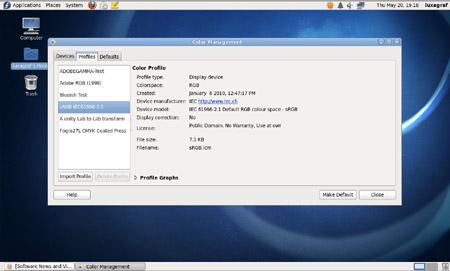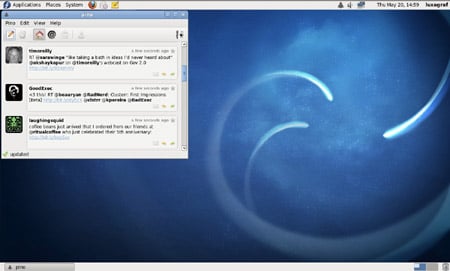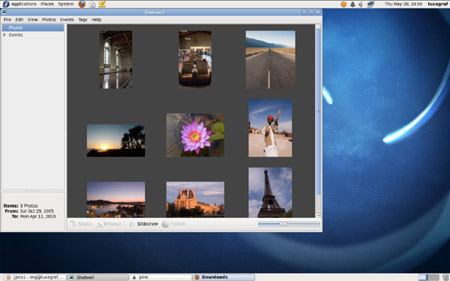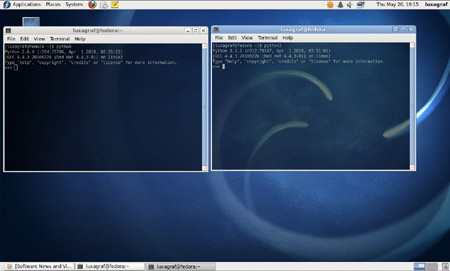Original URL: https://www.theregister.com/2010/05/25/fedora_13_review/
Fedora 13 – Linux for Applephobes
Polish without the Ubuntu
Posted in OSes, 25th May 2010 16:21 GMT
Review With its music store and cloud syncing services, Ubuntu 10.04 tends to eclipse Fedora in the minds of many.
Not that Fedora project leader Paul Frields minds. He's told me in the past that Fedora is intended "first and foremost for users interested in and capable of contributing to open source."
And when I spoke to Frields shortly before the release of Fedora 13 - out today - he reiterated that point. "We want a culture of contribution, not just consumption," he said.
That focus on the more tech savvy, contributing users is reflected in Fedora 13, where you'll find open source, 3D-capable graphics drivers, excellent Python tools, some very nice color management tools, and other less flashy improvements.
Fedora 13 offers open-source 3D acceleration for Nvidia graphics cards. Previously, 3D support was to be had only through the proprietary drivers. The new Nouveau drivers mean those of you with Nvidia cards now have an open-source option that still offers 3D support.
While that will appeal to free software enthusiasts, it also - perhaps more importantly - means that Fedora can be repackaged and distributed without any fear of proprietary drivers.

A colour-management system for graphics professionals and photo enthusiasts
If you've been using the old, proprietary Nvidia drivers, I highly suggest giving the open source versions a try.
The drivers are part of a longer-term plan. Frields points out there is already 3D support in the open-source Radeon and Intel drivers in Fedora and together the three open drivers pave the way for a more complete 3D stack. With GNOME 3.0 coming up, 3D is going to be more important for more users and Fedora stands above the crowd when it comes to open driver support.
Other new, driver-related improvements in Fedora include support for a host of new webcams, including the new so-called dual-mode cameras.
Another big area of development is virtualization. Red Hat has decided KVM is the future of Linux virtualization. The recent RHEL 6 beta dumped Xen in favor of KVM, and Fedora is no different.
New features in KVM include the ability to reserve PCI addresses for guest virtual machines and give virtual machines a shared physical network interface so that guests appear independently on the same network as the host machine.
While neither of these new features will matter to desktop users, they go a along way to making Fedora a more compelling choice for production servers running multiple virtual machines.
Of course, Fedora 13 isn't all technical changes under the hood. In fact, this is probably the most user-friendly release yet from the Fedora community.

Pino connects to Twitter and Identi.ca for social networkers
Lest you think Ubuntu is the only "fun" distro out there, Fedora 13 does have a few nods to current trends in the Linux desktop, like the inclusion of Pino, a social networking app that can connect to Twitter and Identi.ca. Pino gets menu-bar status in this release of Fedora and offers roughly the same experience as gwibber, which shipped with Ubuntu.
Fedora 13 also boasts an entirely new color management system - courtesy of Fedora contributor Richard Hughes - for the Gnome desktop. The new profile manager makes it easy to install vendor-supplied ICC or ICM profile files - just double-click them to config.
For the average person, color management probably never comes up. You turn on your monitor and it's done. But for graphics professionals and photo enthusiasts this is a fine art. Indeed, one of the reasons Apple's OS X is popular is it makes it easy to manage color profiles. If Ubuntu really wants to mimic OS X, it would do well to steal the new color management tool from Fedora 13.
Pictures and Python
Until it does, if you want an easy to use but powerful way to calibrate your monitor for any input device such as printers and cameras, Fedora 13 delivers the goods.
Fedora 13 also packs a new photo management tool, Shotwell. Due to size constraints FSpot was never included in past LiveCDs, though it has always been available as a download.
Shotwell gives Fedora a lightweight, out-of-the-box photo management app. While it isn't as full-featured as FSpot, Shotwell is easy to use and will handle your basic photo needs. If you prefer FSpot it's only a click away in Fedora's repositories.

Photo management comes with Shotwell
Fedora includes Firefox 3.6 version with support for HTML5 video, provided the video is encoded using the Ogg Theora video codec. Fedora was among the first to ship the new Theora 1.1, a much-improved version of the open video codec which features video quality on par with proprietary solutions like H.264. If you want support for Google's new open source video format, WebM, you'll need to install a Firefox nightly build.
Other nice features in Fedora 13 include automatic printer driver installation - which means if you plug in a supported printer, the driver is downloaded and installed automatically. It's not the most exciting feature in the release seen, but it does add another "it-just-works" element to the already very user-friendly distro.
Python programmers will be happy to know that Fedora 13 comes with a "parallel-installable" Python 3 environment that will make it easy for those looking to upgrade their code to test in both Python 2.6 and 3.0, without the need to install Python 3.0 from scratch. Once installed, Python 3 can be invoked simply by typing "python3" while "python" will launch the standard Python 2.6.

No need to install Python 3.0 from scratch
Fedora's Anaconda installer has also been reworked again, offering what Fedora's release notes call "a simpler workflow for desktop and laptop users." Essentially, there are few options to decipher during the installation process, though most of the old fine-tuning menus are still available to advanced users who want to access them.
Fedora is a somewhat GNOME-biased distro, but there are KDE "spins" as the Fedora project calls them. Fedora 13 ships with KDE 4.4, the latest stable version of KDE. Version 4.4 offers a number of PulseAudio improvements, as well as the new timeline view in the Dolphin file manager and quite a bit more.
Fedora has long had a reputation as the Linux you use when you grow up, when you get more sophisticated, and Fedora 13 is no different. Fedora 13 might eschew the flash of Ubuntu in favor of the more serious, but it still packs some useful, new features and applications while being every bit as easy to use.
If Ubuntu is uncomfortable because it leaves you feeling a bit like you're sharing ideals with Apple, take Fedora 13 for a spin. ®